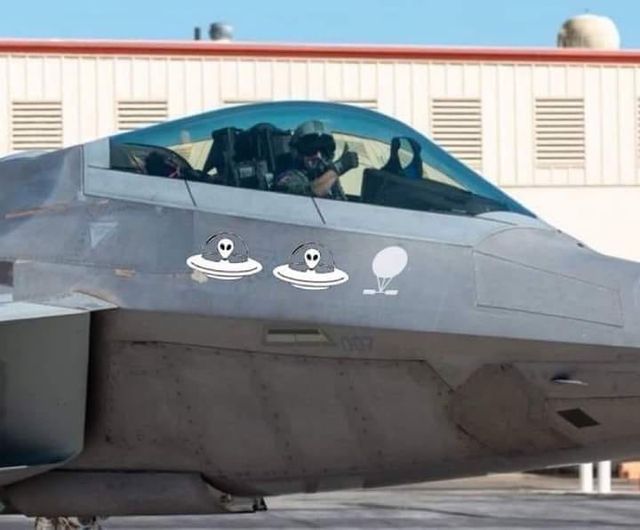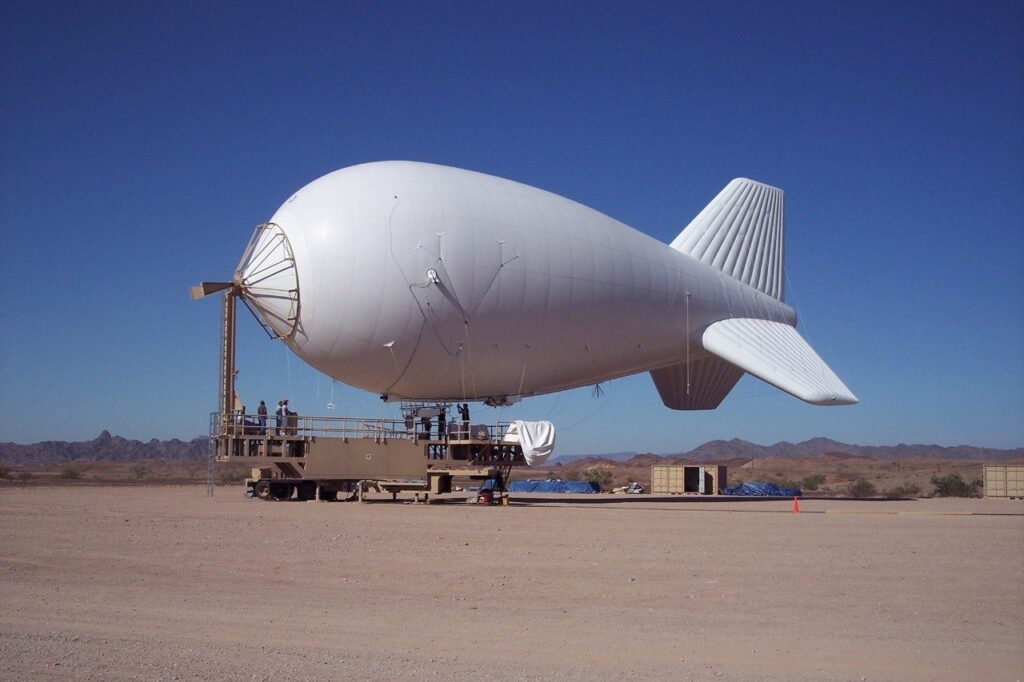
The military has shot down four objects in US and Canadian airspace within the last few days, and this has led to reactions ranging from rational concern to irrational panic.
I’m not saying it was aliens, but…
At a Department of Defense press conference on Feb 12 Helene Cooper of The New York Times asked, “Because you still haven’t been able to tell us what these things are that we are shooting out of the sky, that raises the question, have you ruled out aliens or extraterrestrials? And if so, why? Because that is what everyone is asking us right now.” Gen. Glen VanHerck, commander of North American Aerospace Defense Command (NORAD) and United States Northern Command (USNORTHCOM), answered, “I’ll let the intel community and the counterintelligence community figure that out. I haven’t ruled out anything.”
This bizarre “I haven’t ruled out anything” response from a four-star general to whether alien spacecraft are being shot down was not exactly helpful. Presidential Press Secretary Karine Jean-Pierre was forced the following day to explicitly deny the alien attack rumors: “I just wanted to make sure we address this from the White House. I know there have been questions and concerns about this, but there is no — again, no indication of aliens or extraterrestrial activity — (laughter) — with these recent takedowns. Again, there is no indication of aliens or [extra]terrestrial activity with these recent takedowns. Wanted to make sure that the American people knew that, all of you knew that. And it was important for us to say that from here because we’ve been hearing a lot about it.” That led to a follow-up question: “Would you tell us if there were, really?” Amid laughter, she answered, “I’m just — you know, I loved ‘E.T.,’ the movie. But I’m just going to leave it there.”
A national Associated Press story quoted Jim Ludes, a former national defense analyst who now leads the Pell Center for International Relations at Salve Regina University in RI: “There will be an investigation and we will learn more, but until then this story has created a playground for people interested in speculating or stirring the pot for their own reasons… In part, because it feeds into so many narratives about government secrecy.”
John Hoopes sarcastically posted on Twitter: “Big Astronomy is covering up the reality of extraterrestrial UFOs the same way Big Archaeology is covering up the reality of an advanced ancient civilization of the Ice Age.” Hoopes, an anthropology professor at the University of Kansas, is widely known as a public intellectual for his campaign to debunk the lunatic pseudo-scientific conspiracy theories advanced on the NetFlix series Ancient Apocalypse that argues, among other things, folkloric legends such as the lost continent of Atlantis are historically true.
Open Skies
The alien spacecraft stuff aside, why is anyone upset about this at all?
Nations have flown reconnaissance missions over foreign territory since the invention of aircraft: military balloons were in use as early as the French Revolution in the 1790s and in widespread use by the time of the American Civil War in the 1860s.
Balloons have not usually been perceived as threatening per se. In the final months of World War II between November 1944 and April 1945, Japan launched 9,300 “Fu-Go” balloon bombs with the expectation they would be carried by the atmospheric jet stream and start fires in the Pacific Northwest region of the continental United States. Although about 300 of the balloon bombs were found or observed, only one had any noticeable effect, killing the pastor’s wife and five children on a Sunday school picnic in the Fremont National Forest in Oregon.
From 1947 to 1949, the US Project Mogul flew reconnaissance balloons over the Soviet Union equipped with microphones capable of detecting the sound of nuclear tests; it was an early example that crashed near Roswell, New Mexico, that gave rise to the original alien spacecraft rumor. The US Project Genetrix (WS-119L) was a more advanced photographic surveillance balloon that was regularly flown over Russia and China in the 1950s at altitudes of up to 100,000 feet until it was largely replaced by the U-2 aircraft. In the mid-1950s, the US experimented with the E77 balloon bomb intended to disseminate chemical or biological weapons to destroy crops; it never entered production or deployment. The US Project Flying Cloud (WS-124A) was another balloon delivery system for chemical or biological weapons, but it was dismissed after testing as infeasible and ineffective. The US currently maintains a fleet of “aerostat” balloons as part of the Persistent Threat Detection System used in Afghanistan and Iraq to monitor hostile movements such as planting improvised explosive devices (IEDs) along roadways.

The US has employed the Lockheed U-2 aircraft since 1955 and still maintains a fleet in active service: one was shot down over Russia in 1960 (pilot Francis Gary Powers was captured and repatriated in a prisoner exchange) and another over Cuba in 1962 (pilot Rudolf Anderson Jr. was killed). The 1962 incident came in the context of the Cuban Missile Crisis, which was itself a consequence of the US detecting Soviet nuclear weapons in Cuba from U-2 aerial photos; Maj. Anderson was the only American casualty of the crisis that threatened to set off World War III.
“Freedoms of the Air” is the formal diplomatic term for the post-1944 international standards and agreements that allow free passage of commercial aviation, including refueling and carriage of passengers and cargo, across borders. A comparable rubric for military aviation was proposed by President Dwight D. Eisenhower in 1955, and the Treaty on Open Skies finally came into existence under President George H.W. Bush in 1989, ratified by the US-allied NATO and the Soviet Union-allied Warsaw Pact in 1992; President Donald Trump withdrew the US during his lame-duck period between losing the presidential election in November 2020 and the inauguration of President Joe Biden in January 2021. The Open Skies concept, according to Eisenhower, was to allow each country to verify that other countries were not unilaterally preparing or mobilizing for war or otherwise violating arms control agreements.
Why balloons?
Balloons are cheap and easy to deploy. In 2009, MIT students Oliver Yeh and Justin Lee headed a few miles westward to the town of Sturbridge where they launched a $150 helium balloon project carrying a burner phone and digital camera that sent back real-time photos every few seconds, reaching an altitude of 93,000 feet (almost 18 miles) where the curvature of the earth is plainly visible and the sky appears as the blackness of outer space. In 2018, we reported on a Brown University student group building an earth-orbiting satellite: before members were qualified to work on the satellite project, they were introduced by building a balloon project. One of the project leaders said, “A lot of our first-years and sophomores join the high-altitude balloon team. We’ve launched two and they have 360-degree cameras, and they were either the first or the second 360-degree cameras on high-altitude balloons, the highest 360-degree cameras ever, [reaching 80,000 feet]. We put on electronics kind of similar to what we have on the satellite, such as an altimeter – which is not on the satellite – but also gyroscope, magnetometer, accelerometer, temperature. Each balloon tests something that we want to test for the satellite.”
There is a commercial weather balloon industry and it is estimated that about 300 are launched daily on average in the US. Weather Scientific sells the Kaymont HAB-100 for $19.00 and – I’m writing this on Feb 14 – has a Valentine’s Day discount offer. Scientific Sales has a selection from 10g capacity for $6.00 to 3kg capacity for $395.00. You can also buy instruments from them if you’re not inclined to the DIY approach like the MIT and Brown students. If you’re really hard up on the budget, Amazon will sell you a package of five 36-inch latex balloons for $10.00.
Why are we shooting down these objects?
The Chinese spy balloon that started the present frenzy was reported by US defense intelligence agencies as having flown from China to Alaska, then over Canada, and finally into the continental United States. My inference is that it was intended to maintain an altitude of about 100,000 feet but something went wrong and it descended instead to about 60,000 feet, at which point it was visible to the naked eye over Montana. With ordinary private citizens able to see it just by looking up into the sky, or at least with little more than a decent set of binoculars, that put the US government into an awkward position where they had to acknowledge its existence. Despite statements by defense and intelligence professionals who assessed the spy balloon as posing little threat, especially because China has numerous sophisticated surveillance satellites in earth orbit but probably decided to use balloons to save money.
The Biden administration came under heavy political criticism, especially from Republicans in Congress, for not shooting down the balloon as soon as it entered American airspace over Alaska, but we have never done anything like that before. We especially do not want to get into a situation where we shoot at their surveillance systems and they shoot at ours, for exactly the reasons Eisenhower explicitly articulated that some surveillance serves the interest of preserving peace. It was also revealed that this Chinese spy balloon was the fifth known incursion into US airspace since 2017, although as noted the military did not seem to see these as any threat worth responsive action. Of course, the lack of response may have been a mistake emboldening China to grow increasingly aggressive, eventually permitting their balloon to be seen from the ground. (The Chinese claim that the balloon was a meteorological research project is laughable.) It has also been revealed that US intelligence was aware of an extensive Chinese spy balloon project overflying 40 countries on five continents.
The first balloon was shot down off the coast of South Carolina by a US F-22 fighter jet using an AIM-9X Sidewinder missile. (Live video: twitter.com/RealPhotoholic/status/1622284634703765505.) The same type of missile was used to shoot down the next three objects over Alaska, the Canadian Yukon, and Michigan. At $400,000 per missile, it’s not sustainable to shoot down everything that looks kind of like a balloon.
NORAD gathers an avalanche of radar and sensor data about everything flying in or above the atmosphere, reportedly as small as a grain of rice, and they have to filter these huge quantities of information in order to discard anything they can dismiss as no threat. They have spent decades looking for things that are big and fast, such as bomber aircraft or intercontinental ballistic missiles (ICBMs), so everything small and slow was pretty much ignored. After the Chinese spy balloon fracas, now they seem to be letting balloon-like objects through their filters and this is why we shot down three more objects without even fully understanding what they are.
Why are we shooting down these objects? Maybe the government knows and they’re not telling us. Maybe the government doesn’t know, either. Maybe these are homemade weather balloons constructed by a couple of ambitious college students or hobbyists.
At some point, we’re going to run into a revival of Lawnchair Larry, a man who in 1982 tied 45 helium balloons to an aluminum chair and ascended to an altitude of 16,000 feet, shutting down Long Beach Airport in California. After he landed, an inspector from the Federal Aviation Administration famously said, “We know he broke some part of the Federal Aviation Act, and as soon as we decide which part it is, some type of charge will be filed. If he had a pilot’s license, we’d suspend that, but he doesn’t.” At least he didn’t face a Sidewinder missile.


